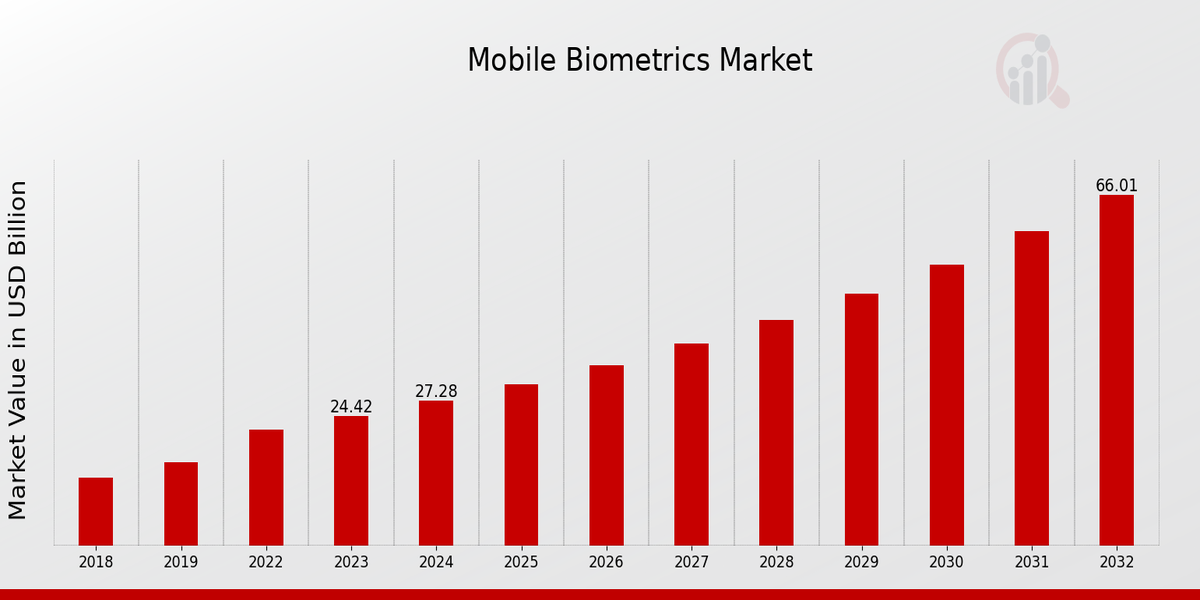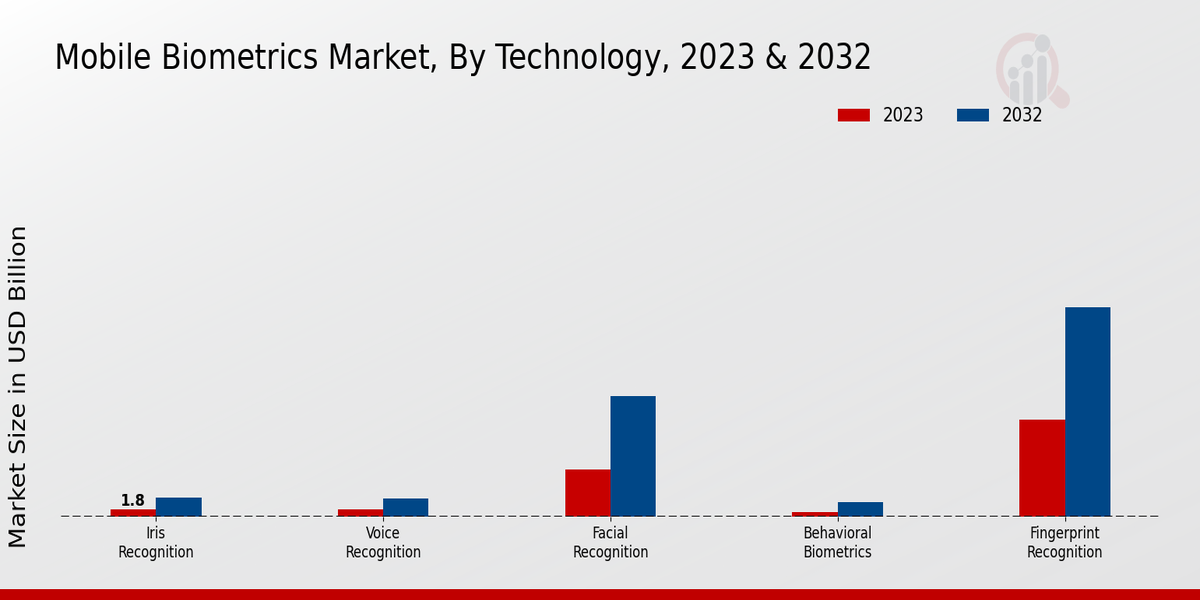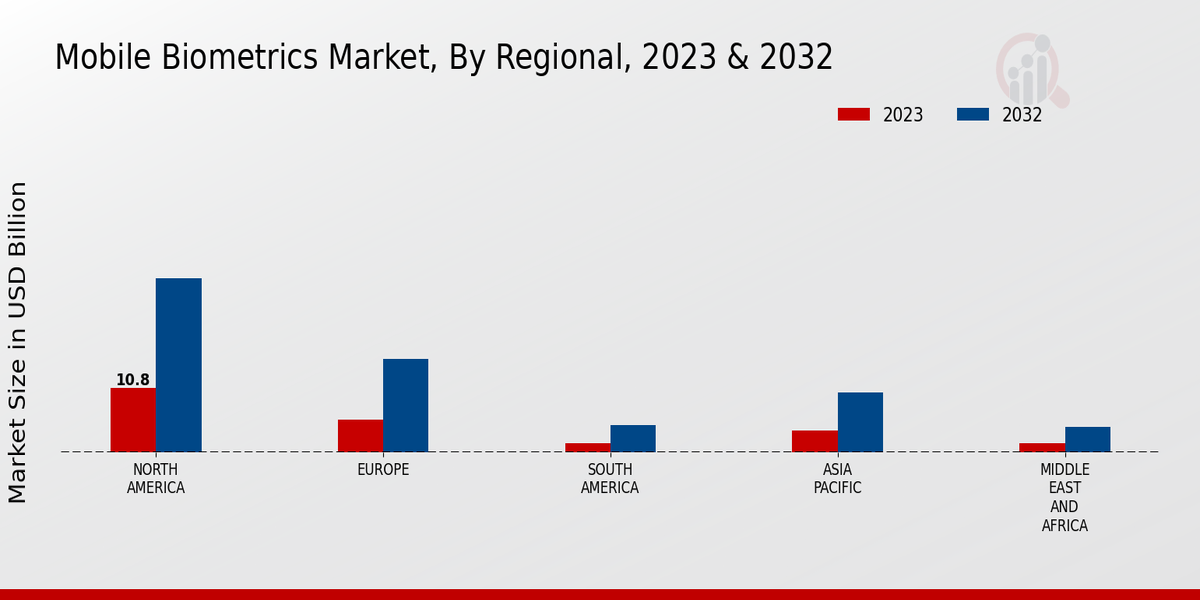Mobile Biometrics Market Overview
Mobile Biometrics Market Size was estimated at 21.87 (USD Billion) in 2022. The Mobile Biometrics Market Industry is expected to grow from 24.42(USD Billion) in 2023 to 66.0 (USD Billion) by 2032. The Mobile Biometrics Market CAGR (growth rate) is expected to be around 11.68% during the forecast period (2024 - 2032).
Key Mobile Biometrics Market Trends Highlighted
The Mobile Biometrics Market is poised for significant growth driven by increasing demand for enhanced security measures in various sectors, including banking, healthcare, and retail. The advent of smartphones equipped with advanced biometric sensors, such as fingerprint scanners and facial recognition systems, has spurred the adoption of mobile biometrics.
Key market drivers include rising concerns over data security, the need for convenient and secure authentication methods, and government regulations requiring strong user identification. Furthermore, the integration of mobile biometrics with emerging technologies, such as artificial intelligence (AI) and the Internet of Things (IoT), opens up new opportunities for advanced security solutions.
Recent trends in the mobile biometrics market include the increasing adoption of multi-modal biometrics, which combines multiple biometric traits for enhanced security. Additionally, the development of contactless biometric technologies, such as facial recognition and iris scanning, is gaining traction. Furthermore, the growing popularity of biometric payments and digital wallets is expected to further drive market growth.

Source: Primary Research, Secondary Research, Market Research Future Database and Analyst Review
Mobile Biometrics Market Drivers
Increasing Demand for Enhanced Security and Convenience
The increasing importance of reliable security measures and convenience of performance in a variety of industries is one of the main elements that have contributed to the growth of the Mobile Biometrics Market Industry. On the one hand, mobile biometrics offers an effective and convenient way to identify users without the need for passwords or similar characteristics, and its reliability is increased by the use of physical and behavioral traits of each person. In mobile banking, e-commerce, and various control systems, this technology may be applied with success.
On the other hand, the increased awareness about the dangers of a data breach highlights the importance of such measures.
Advancements in Biometric Technologies
The enhancements and significant advancements achieved in the technology of biometrics are increasing the precision and functionality of mobile biometrics. The development of fingerprint, facial, and voice algorithms enhances the speed, accuracy and reliability of the authentication process. The integration of several modalities, such as fingerprint and facial, has enhanced the security levels. In addition, the technology has been enhanced by developing contactless biometric sensors, which are crucial for ensuring users are authenticated without the system contacting the surface.
This is crucial due to the hygienic nature and faster authentication meaning the devices can be used even in high traffic prone areas.
Growing Adoption in Healthcare and Finance
The healthcare and finance sectors are witnessing a significant increase in the adoption of mobile biometrics. In healthcare, mobile biometrics enhances patient safety and streamlines healthcare processes. It enables secure access to patient records, reduces medication errors, and provides personalized treatment plans. Within the finance industry, mobile biometrics safeguards financial transactions, prevent fraud and facilitate secure mobile banking. The ability to authenticate users quickly and accurately reduces the risk of unauthorized access to sensitive financial information, making mobile biometrics a valuable asset in these industries.
Mobile Biometrics Market Segment Insights
Mobile Biometrics Market Technology Insights
The Mobile Biometrics Market is segmented based on technology into fingerprint recognition, facial recognition, iris recognition, voice recognition, and behavioral biometrics. Fingerprint recognition dominates the market and accounts for approximately 45% of the revenue in 2023, attributable to its maturity, cost advantages, and user-friendliness. Moreover, it is one of the most commonly used biometric identification options. However, facial recognition is projected to grow at the fastest CAGR during the forecast period, driven by the rise in the use of deep learning and computer vision algorithms and the increasing adoption of smartphones and other mobile devices.
Fingerprint recognition utilizes the one-of-a-kind patterns of an individual’s finger for identification. It is used in mobile banking, mobile payments, and access control, among other applications. Facial recognition technology scans the facial features of users to create a biometric template and is more secure than finger recognition for user identification. Moreover, it is increasingly being used in smartphones and surveillance systems. Iris recognition technology examines the unique markings of an individual’s iris structure for identification.
It is highly accurate and secure compared to other biometric methods, though it may be more costly and difficult to implement. Voice recognition technology verifies individuals based on their vocal characteristics. It is increasingly being employed in mobile devices for hands-free user identification and voice response commands. Behavioral biometrics technology assesses users based on various behavioral patterns, including typing rhythm, walk style, and keystroke pressure. It provides continuous authentication and is widely used in mobile devices for fraud prevention and data security.
The rising use of mobile devices and the increased willingness to heighten security in several application areas are propelling the market growth.

Source: Primary Research, Secondary Research, Market Research Future Database and Analyst Review
Mobile Biometrics Market Application Insights
The Mobile Biometrics Market is divided into Authentication, Identification, Access Control, Fraud Prevention, and Transaction Security based on Application. The Authentication segment has the highest market share in 2023 and is foreseen to lead the industry during the forecast period. The growth of the segment can be majorly attributed to the growing need for mobile biometrics for user authentication in different applications, such as mobile banking and e-commerce, owing to the rise in internet fraud.
The Identification segment is expected to grow at the highest CAGR as the demand for mobile biometrics for identity purposes is increasing in law enforcement, border control, and healthcare industries. On the other hand, the application of Access Control, Fraud Prevention, and Transaction Security segments is predicted to boost the market growth to a noteworthy extent.
Mobile Biometrics Market End-User Industry Insights
The Mobile Biometrics Market is segmented by end-user industry into Banking, Financial Services and Insurance (BFSI), Government and Public Sector, Healthcare, Retail, and Transportation and Logistics. The BFSI segment is expected to hold the largest market share in the coming years due to the increasing adoption of mobile biometrics for secure authentication and fraud prevention.
The Government and Public Sector segment is also expected to witness significant growth due to the rising demand for mobile biometrics for border control, law enforcement, and national security applications.The Healthcare segment is expected to grow at a steady pace due to the increasing use of mobile biometrics for patient identification and access control. The Retail segment is also expected to witness growth due to the increasing adoption of mobile biometrics for self-checkout and mobile payments.
The Transportation and Logistics segment is expected to grow due to the increasing use of mobile biometrics for secure access to vehicles and cargo tracking.
Mobile Biometrics Market Form Factor Insights
The Mobile Biometrics Market segmentation by Form Factor includes Integrated Smartphones, Integrated Tablets, Integrated Laptops, and Standalone Devices. Integrated in the Smartphones segment held the largest market share in 2023, accounting for over 50% of the Mobile Biometrics Market revenue. The widespread adoption of smartphones and the increasing demand for enhanced security features are driving the growth of this segment. Integrated in Laptops segment is expected to witness significant growth over the forecast period due to the rising adoption of laptops for both personal and professional use.
The Standalone Devices segment is expected to grow at a steady pace due to their use in various applications such as access control, time and attendance tracking, and identity verification.
Mobile Biometrics Market Deployment Model Insights
The Mobile Biometrics Market is segmented into on-premise and cloud-based deployment models. The cloud-based segment is projected to grow at a higher CAGR during the forecast period due to the increasing adoption of cloud-based services by enterprises. Cloud-based deployment offers several advantages over on-premise deployment, such as reduced infrastructure costs, increased scalability, and enhanced security. The on-premise segment, however, is expected to hold a larger market share during the forecast period due to the high adoption of on-premise solutions by organizations with stringent security requirements.
The Mobile Biometrics Market revenue for the on-premise segment is expected to reach $15.4 billion by 2024. The Mobile Biometrics Market revenue for the cloud-based segment is expected to reach $9.5 billion by 2024.
Mobile Biometrics Market Regional Insights
The Mobile Biometrics Market is segmented into North America, Europe, APAC, South America, and MEA. North America is expected to hold the largest market share in 2023, owing to the early adoption of mobile biometrics technology in the region. Europe is expected to be the second largest market, followed by APAC. APAC is expected to witness the highest growth rate during the forecast period due to the increasing adoption of mobile biometrics in emerging economies such as China and India.
South America and MEA are expected to have a relatively small market share but are expected to grow at a steady pace. The Mobile Biometrics Market is expected to be driven by the increasing demand for secure and convenient authentication methods, the growing adoption of mobile devices, and the increasing government regulations mandating the use of biometrics for authentication.

Source: Primary Research, Secondary Research, Market Research Future Database and Analyst Review
Mobile Biometrics Market Key Players And Competitive Insights
Major players in the Mobile Biometrics Market are focusing on innovation and product development to gain a competitive edge. New market entrants are also emerging, bringing in fresh ideas and solutions. The industry is expected to witness collaborations and partnerships among key players to strengthen portfolios and expand market reach. To stay competitive, leading Mobile Biometrics Market players are adopting advanced technologies, such as artificial intelligence (AI), machine learning (ML), and cloud computing, to provide enhanced solutions.
Moreover, companies are engaging in strategic mergers and acquisitions to expand their offerings, increase their market share, and strengthen their position in the industry.One of the leading players in the Mobile Biometrics Market is Qualcomm Technologies. The company offers a wide range of mobile biometrics solutions, including fingerprint sensors, facial recognition technology, and iris recognition technology. Qualcomm Technologies has a strong presence across various regions and has established partnerships with leading smartphone manufacturers. The company is continuously investing in research and development to enhance its mobile biometrics offerings and maintain its market position.
A key competitor in the Mobile Biometrics Market is Fingerprint Cards. The company specializes in fingerprint recognition technology and offers a variety of fingerprint sensors for mobile devices. Fingerprint Cards has a strong global presence and has established relationships with major smartphone manufacturers. The company is focused on delivering innovative and secure fingerprint recognition solutions to meet the evolving needs of the market. Fingerprint Cards invests heavily in research and development to stay ahead of the competition and maintain its position as a leading provider of fingerprint recognition technology.
Key Companies in the Mobile Biometrics Market Include
Mobile Biometrics Industry Developments
-
Q2 2024: Fingerprint Cards launches new biometric payment card solution for mobile devices Fingerprint Cards AB announced the launch of a new biometric payment card solution designed for integration with mobile devices, aiming to enhance secure transactions and user authentication.
-
Q2 2024: Apple secures regulatory approval for Face ID technology expansion in mobile banking apps Apple received regulatory approval to expand the use of its Face ID biometric authentication technology into third-party mobile banking applications, marking a significant step in mobile biometrics adoption.
-
Q2 2024: Samsung partners with Idemia to integrate advanced biometric authentication in Galaxy smartphones Samsung announced a partnership with Idemia to integrate advanced fingerprint and facial recognition technologies into its upcoming Galaxy smartphone lineup, strengthening mobile device security.
-
Q3 2024: NEC launches new multimodal biometric authentication platform for mobile devices NEC Corporation unveiled a new multimodal biometric authentication platform, combining facial, fingerprint, and voice recognition for enhanced security in mobile applications.
-
Q3 2024: Zwipe raises $15 million in Series B funding to accelerate mobile biometric solutions Zwipe, a biometric technology company, secured $15 million in Series B funding to expand its mobile biometric authentication solutions for payment and access control.
-
Q3 2024: HID Global announces partnership with Vodafone for mobile biometric identity verification HID Global entered into a partnership with Vodafone to provide mobile biometric identity verification services for Vodafone's customer onboarding and authentication processes.
-
Q4 2024: Google launches biometric authentication API for Android developers Google released a new biometric authentication API for Android developers, enabling easier integration of fingerprint and facial recognition features into mobile applications.
-
Q4 2024: Aware, Inc. wins contract to provide mobile biometric authentication for government e-services Aware, Inc. was awarded a contract to supply mobile biometric authentication technology for secure access to government e-services, focusing on facial and fingerprint recognition.
-
Q1 2025: BioCatch appoints new CEO to drive mobile biometrics expansion BioCatch, a behavioral biometrics company, announced the appointment of a new CEO to lead its strategic expansion in mobile biometrics for financial services.
-
Q1 2025: Aratek opens new manufacturing facility for mobile biometric devices in Vietnam Aratek inaugurated a new manufacturing facility in Vietnam dedicated to producing mobile biometric devices, aiming to meet growing demand in Southeast Asia.
-
Q2 2025: Mastercard partners with Thales to launch biometric payment cards for mobile wallets Mastercard and Thales announced a partnership to launch biometric payment cards compatible with mobile wallets, enhancing security for digital transactions.
-
Q2 2025: Nuance Communications secures contract to provide voice biometrics for mobile healthcare apps Nuance Communications won a contract to supply voice biometric authentication technology for mobile healthcare applications, improving patient data security and access.
Mobile Biometrics Market Segmentation Insights
Mobile Biometrics Market Technology Outlook
- Fingerprint Recognition
- Facial Recognition
- Iris Recognition
-
Voice Recognition Behavioral Biometrics
Mobile Biometrics Market Application Outlook
- Authentication
- Identification
- Access Control
- Fraud Prevention
-
Transaction Security
Mobile Biometrics Market End-User Industry Outlook
- Banking, Financial Services and Insurance (BFSI)
- Government and Public Sector
- Healthcare
- Retail
- Transportation and Logistics
Mobile Biometrics Market Form Factor Outlook
- Integrated in Smartphones
- Integrated in Tablets
- Integrated in Laptops
-
Standalone Devices
Mobile Biometrics Market Deployment Model Outlook
Mobile Biometrics Market Regional Outlook
- North America
- Europe
- South America
- Asia Pacific
- Middle East and Africa
Mobile Biometrics Market Report Scope
| Report Attribute/Metric |
Details |
| Market Size 2022 |
21.87(USD Billion) |
| Market Size 2023 |
24.42(USD Billion) |
| Market Size 2032 |
66.0(USD Billion) |
| Compound Annual Growth Rate (CAGR) |
11.68% (2024 - 2032) |
| Report Coverage |
Revenue Forecast, Competitive Landscape, Growth Factors, and Trends |
| Base Year |
2023 |
| Market Forecast Period |
2024 - 2032 |
| Historical Data |
2019 - 2023 |
| Market Forecast Units |
USD Billion |
| Key Companies Profiled |
OnePlus, Fingerprints, Samsung, IDEMIA, Thales Group, Vivo, Apple, BIOkey International, iProov, Aware Inc., Suprema, Zwipe, Xiaomi, M2SYS Technology, Precise Biometrics |
| Segments Covered |
Technology, Application, End-User Industry, Form Factor, Deployment Model, Regional |
| Key Market Opportunities |
Biometric authentication for digital payments Enhanced security in mobile banking Growing adoption in healthcare Increasing demand for mobile ID verification Remote workforce authentication |
| Key Market Dynamics |
Rising demand for enhanced security growing adoption of mobile devices technological advancements increasing government initiatives expanding healthcare applications |
| Countries Covered |
North America, Europe, APAC, South America, MEA |
Frequently Asked Questions (FAQ):
The Mobile Biometrics Market is projected to reach a valuation of USD 24.42 billion by 2023 and is expected to register a CAGR of 11.68% from 2024 to 2032.
North America is expected to dominate the market, accounting for over 40% of the global market share by 2032.
The increasing adoption of mobile devices, rising security concerns, and government initiatives to promote digital identity are the primary growth drivers of the market.
The mobile banking and payment segment is expected to register the highest growth rate, driven by the growing use of mobile banking and payment solutions.
Major players in the market include Qualcomm, Fingerprint Cards AB, Synaptics, Apple, and Samsung Electronics.
Data privacy and security concerns, limited accuracy of biometric technologies, and high implementation costs are some of the key challenges faced by the market.
Integration of AI and machine learning, development of new biometric modalities, and the rise of multi-factor authentication are among the key emerging trends.
The market is projected to reach a valuation of USD 66 billion by 2032, representing a significant growth opportunity.
Enhanced security, convenience, and the proliferation of mobile devices are driving the adoption of mobile biometrics.
Government regulations related to data privacy and security are influencing the development and deployment of mobile biometrics solutions.

















